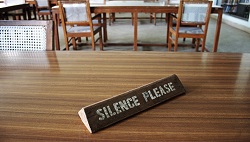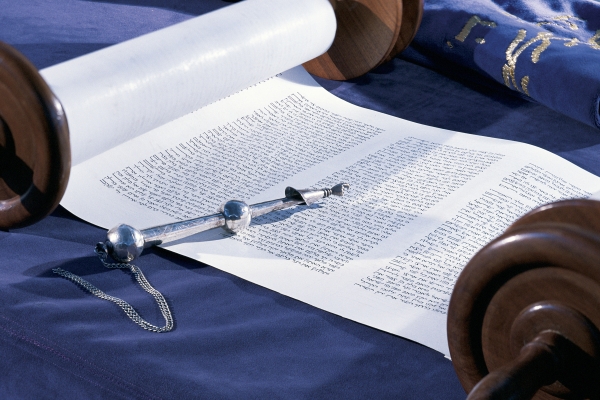 In the story of Elijah, this classic text describes the prophet’s encounter with God:
In the story of Elijah, this classic text describes the prophet’s encounter with God:
“There was a great and mighty wind, splitting mountains and shattering rocks by the power of the Eternal; but the Eternal was not in the wind. After the wind—an earthquake; but the Eternal was not in the earthquake. After the earthquake—fire; but the Eternal was not in the fire. And after the fire—a soft murmuring sound [kol d’mamah dakah].” (I Kings 19:11-12)
The sound of silence—or close to it. The power of the soft whisper. The energy of the absence of sound. Jewish tradition, and the Torah specifically, uses many examples of the drama that can be achieved with sound, from the thunder of Sinai to the silence of Aaron facing the death of his sons. Sound, and the lack of sound, call us to attention.
Parashat Ki Tavo plays the concept of sound in a variety of ways. Toward the beginning of the portion, both sound and the lack of sound are used to emphasize importance to the Israelite community.
“Moses and the levitical priests spoke to all Israel, saying: Silence! Hear, O Israel! Today you have become the people of the Eternal your God: Heed the Eternal your God and observe the divine commandments and laws, which I enjoin upon you this day. Thereupon Moses charged the people, saying: After you have crossed the Jordan, the following shall stand on Mount Gerizim when the blessing for the people is spoken: Simeon, Levi, Judah, Issachar, Joseph, and Benjamin. And for the curse, the following shall stand on Mount Ebal: Reuben, Gad, Asher, Zebulun, Dan, and Naphtali. The Levites shall then proclaim in a loud voice to all the people of Israel: Cursed be anyone who makes a sculptured or molten image, abhorred by the Eternal, a craftsman’s handiwork, and sets it up in secret.—And all the people shall respond, Amen.” (Deut.27:9-15; emphasis is mine).
In the span of these few verses, Moses commands both silence and increased volume as a way to highlight key concepts.
But Parashat Ki Tavo is most famous for another striking contrast in sound—one that involves not the words of the text itself, but how that text is read or chanted aloud in our contemporary communities of practice. Deuteronomy 28:15-68 is known as the tocheichah, the “rebuke.” This section contains a long list of curses that will befall the Israelites if we betray our promise to uphold our side of our covenant with God. Although this list of curses is certainly not the only place in the Torah that admonishes the Israelites for potentially bad behavior, this particular list (together with another similar list in Leviticus 26) is so long and so severe, that the practice is to read these verses quickly and quietly.
Where does this tradition come from, and what does this performance practice signal to or trigger for those of us in the congregation? The Talmud already marks these verses as ones to be handled specially and carefully. In M’gillah 31b, we learn that the lists of curses cannot be interrupted: they cannot be split into two aliyot and read by two different people:
On fast days the congregation reads the portion of blessings and curses (Leviticus, chapter 16), and one may not interrupt the reading of the curses by having two different people read them. Rather, one person reads all of them. The Gemara asks: From where are these matters derived? Why does one not interrupt the reading of the curses? Rabbi Ḥiyya bar Gamda said that Rabbi Asi said: For the verse states: “My son, do not despise the chastening of the Lord, nor be weary of His correction” (Proverbs 3:11). If one makes a break in the middle of the curses, it appears as if he loathes rebuke (William Davidson Talmud translation; bolded selections are in the original).
Later on the page, we learn that this practice of not interrupting is required for the Leviticus curses, but only suggested for the Deuteronomy curses:
Rav Huna said … with regard to the curses that are recorded in Deuteronomy, one may interrupt them by having two different people read them. (ibid.)
Nonetheless, the principle remains the same: There is something about a list of curses that requires us to pronounce them aloud in a particular way.
The Kitzur Shulchan Aruch, a summary of the Shulchan Aruch written by Rabbi Joseph Karo, introduces the additional concept of a shift in dynamics:
The curses contained in parshas Bechukosai and in parshas Ki Savo should be read without interruption (M’gillah 31). Interrupting would make it appear as though we do not wish to accept Divine admonition. ... And also the curses in parshas Bechukosai and parshas Ki Savo should be read in a low voice. ... And in parshas Ki Savo, [the verse] Leyira es Hashem hanichbad [to fear the honored Name] until the end of the verse should be read in a loud voice and thereafter in a low voice until Ve'ein koneh [and there is no one to buy]. ... and the reason is to show that they were regretful. Whatever is read in a low voice should be read at least [loud enough] for the congregation to hear the voice, otherwise they have not fulfilled their duty of reading [the Torah]. (Kitzur Shulchan Aruch 78:4; Rabbi Avrohom Davis, trans. [Metsudah Pub., 1996).
Here, the law code makes clear not only that we should read the curses quietly, but also that we should punctuate the recitation by returning to a regular or loud voice during the sections that reinforce positive associations—such as the middle and end Deuteronomy 28:58, which reference the name of God with reverence. According to the Kitzur Shulchan Aruch, it is not enough for us to approach this passage simply with a passive gloss on the meaning of the curses; we also must engage in ritual theater to emphasize and enact our emotional connections to this text.
What are we trying to communicate with all of this acoustic dramatic interpretation? How does this sudden decrease in volume make us feel? What does this practice of chanting quietly with occasional contrasts in sound communicate to us as we engage with the words of this portion?
Remorse, regret, and reverence
Both the Talmud and the Kitzur Shulchan Aruch give us initial direction: remorse, regret, and reverence for the Eternal. For these texts, the quiet chanting mimics our emotional height—we feel low when we are sorry. In addition, our abrupt hush signals our willingness and eagerness to listen and connect with God, despite our infractions.
God is a patient teacher
Just as a parent calmly explains the dangers and the consequences of missteps, so too does God quietly inform us of impending repercussions. Through this interpretation of the whispered chant, we reinforce our love for and attachment to the Eternal; we mitigate the harshness of the decrees with mimicked gentleness. For as we learn in B’reishit Rabbah 54:3, Rabbi Yosi ben Chanina said: “A love without reproof is no love.”
We should not tempt fate
For some, the practice of the quiet tones is almost akin to apotropaic magic—the practice of warding away evil with signs, symbols, and rituals. In this understanding, the near silence is a protection, a community sanctioned safety ritual to distance ourselves from both the sins and the consequences listed in this portion.
Although each of these interpretations of our hushed recitation emphasizes a different dimension of our response to the tocheichah, in many ways the contrast of sound is a teacher in itself. The sudden silence calls us to attention, jolts us out of regularity just as much as the shofar rouses us from our slumber. The dramatic drop in volume commands us to be alert and aware. Even as—and perhaps especially as—we recount the potential consequences of the choices we make, actions we take in our lives, we must make room in our collection of daily noise for the still, small voice, the soft, murmuring sound—the kol d’mamah dakah.

While the Sephardi Jewish community starts adding penitential prayers to services at the beginning of the Hebrew month of Elul, the Askenazi Jewish community formally enters the High Holiday period as the sun sets on Saturday, September 21, 2019, with the recitation of Selichot poems and prayers for Divine forgiveness. For Ashkenazi Jews, the first night of Selichot holds immense spiritual power and weight. This period of time helps Jews enter the Yamim Nora-im, the Days of Awe, with a full heart and an open soul. This may also be the first time we hear the sounding of the shofar since the end of N’ilah last Yom Kippur.
The sound of the High Holidays, marked by the soul piercing call of the shofar, is a true wake-up call to all of us. It is this wake-up call that our sidrah, Ki Tavo, alludes to and that Cantor Sacks speaks about. In Deuteronomy 27:9, Moses and the levitical priests instruct all of Israel first to be silent and then to hear a litany of blessings and curses that will be enjoined upon them when entering the Land of Israel. The phrase Sh’ma Yisrael, “Hear, O Israel,” appears a number of times in the Book of Deuteronomy, but this time it is different. Here, we are first told Haskeit!, “Silence!” and then u’sh’ma Yisrael, “and hear O’ Israel!”
The juxtaposition between Haskeit!, “Silence!” and Sh’ma, “Hear,” is quite stark. For only when we silence ourselves do we truly have the ability to hear God and those around us. This, of course, is easier said than done, and yet it is what this time of the year is about. How can we begin to stop and actually be quiet? Do we really know what true silence sounds like?
Perhaps the answer is tucked away in the first verse of Deuteronomy 28, as we read: V’haya im shamoa tishma b’kol Adonai Elohecha... This is often translated as, “Now, if you obey the Eternal your God…” The peculiar grammatical construction. shamoa tishma, does not lend itself to an easy translation. But by attempting to translate each word, we develop a clearer understanding of the difference between shamoa, “[you] hear” and tishma, “you listen.”
Rabbi Yehudah Leib Alter of Ger, the author of the S’fat Emet, a 19th century Chasidic commentary wrote:
“[a Jew's] living soul constantly hears the voice of Torah. But this too is hidden from us. This is why the verse says ‘listen, listen’ — listen to that which you are already hearing. (Arthur Green, translator and interpreter, The Language of Truth [Philadephia: JPS, 2012), p. 325,
Starting tonight, and over the next few weeks, our job is quite simple; we must remain silent long enough so that we can begin to listen and actually start to hear. This call to silence is found in the seconds before the shofar is sounded. In fact, the blessing recited before the sounding of the shofar praises God for commanding us to lishmo-a, “to hear,” the shofar. Our obligation to hear the shofar is ultimately fulfilled through our own ability to stay quiet and listen to what we are already hearing.
In an age where technology may literally be wrapped around our wrist, it is incumbent upon us to find ways to begin to hear that kol d’mamah dakah, the “soft murmuring sound of the still small voice” burning within our soul (I Kings 19:12). Our Torah instructs us to be silent, our Sages implore us to listen, and God commands us to hear. If we can muster up the strength to be fully present, then perhaps over the next few weeks we will merit the reward of hearing God’s call to listen to the cries of humanity. As we begin to say our Selichot prayers during this season of t’shuvah, “repentance,” the power of the sound of silence is found in our ability to truly listen so that we will ultimately hear.
Ki Tavo, Deuteronomy 26:1–29:8
The Torah: A Modern Commentary, pp. 1,508–1,537; Revised Edition, pp. 1,347–1,367
The Torah: A Women’s Commentary, pp. 1,191–1,216
Sixth Haftarah of Consolation, Isaiah 60:1–22
The Torah: A Modern Commentary, pp. 1,614–1,617; Revised Edition, pp. 1,368–1,371
Selichot services begin after Shabbat
Explore Jewish Life and Get Inspired
Subscribe for Emails
